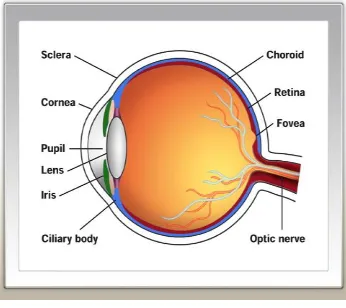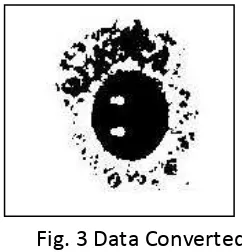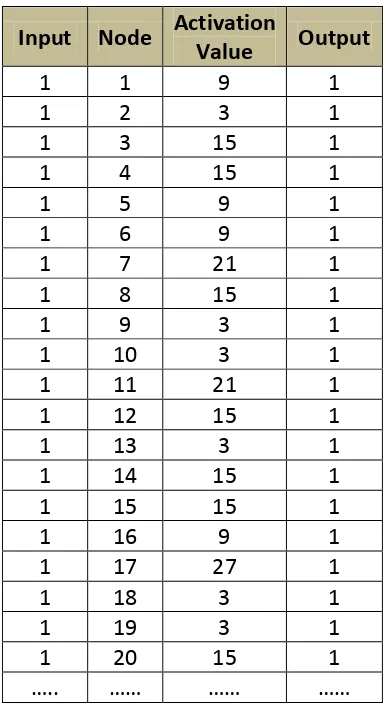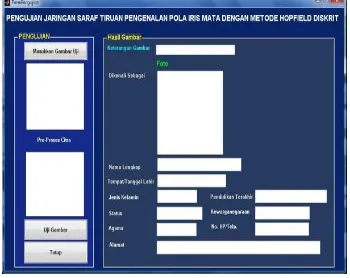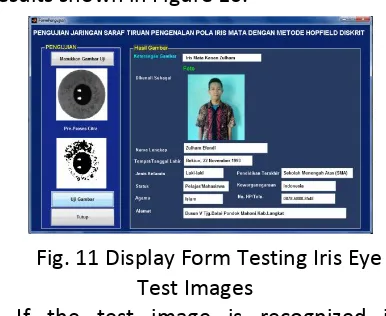1
APPLICATION OF DISCRETE HOPFIELD ALGORTIHM TYPE ARTIFICIAL NEURAL NETWORK FOR PATTERN RECOGNITION OF EYE’S IRIS
Dicky Nofriansyah*1, Zulham Effendi*2 , Mukhlis Ramadhan*3 #1,2,3
Information Technology of STMIK Triguna Dharma, Indonesia E-mail :#[email protected]
ABSTRACT
Artificial Neural Network (ANN) was used to identify the characteristics of the input slice is represented by the binary value. Input from these characteristics trained by discrete Hopfield neural network algorithm for the "recognized" or NOT. Eye’s iris can be used as an alternative to overcome the problems of privacy and data security because of the unique characteristics present in the iris itself. Texture of it, are unique to each person having a texture pattern is stable throughout life, even it left and right eyes of someone else having the same texture. Call was recognized if the output produced in accordance with the trend of network or proximity input pattern to a target pattern. Results from this study is that the system can recognize the characteristics of it in identify more precise and good degree of accuracy, and can distinguish the iris with each other.
Keywords: Eye Iris Recognition, Artificial Neural Networks, Discrete Hopfield Algorithm.
ABSTRAK
Jaringan Saraf Tiruan (JST) digunakan untuk mengidentifikasi karakteristik iris masukan diwakili oleh nilai biner. Masukan dari karakteristik ini dilatih oleh algoritma neural network Hopfield diskrit untuk "diakui" atau tidak. iris mata dapat digunakan sebagai alternatif untuk mengatasi masalah privasi dan keamanan data karena karakteristik unik hadir di iris itu sendiri. Tekstur yang unik untuk setiap orang memiliki pola tekstur stabil sepanjang hidup, bahkan kiri dan kanan mata orang lain memiliki tekstur yang sama. Panggilan diketahui jika output yang dihasilkan sesuai dengan tren jaringan atau kedekatan pola masukan ke pola sasaran. Hasil dari penelitian ini adalah bahwa sistem dapat mengenali karakteristik dalam mengidentifikasi tingkat yang lebih tepat dan akurasi yang baik, dan dapat membedakan iris dengan satu sama lain.
Kata kunci: Eye Iris Recognition, Jaringan Syaraf Tiruan, Discrete Hopfield Algoritma
A.INTRODUCTION
This research is about pattern
recognition of eye’s iris based on Artificial Neural Network.Eyes are the human senses which serves to see an object. In the eyes there are several parts of one of them is sliced. Eye or iris that is part of
the circle encircling the pupil.
for attendance, population data collection and security systems.
The main objectives of the research were as follow:
a. To recognize the characteristics of the iris using a neural network using
DICRETE HOPFIELD Algorithm To
produce software that can analyze the characteristics of DICRETE HOPFIELD Algorithm
b. To determine the results of the testing of the software that has been built in
recognizing the characteristics of the iris with Discrete Hopfield algorithm.
B. BACKGROUND
Eyes are the human senses which serves to see an object. In the eyes there are several parts of one of them is sliced. Eye or iris that is part of the circle encircling the pupil. Characteristic of textures are very detailed and unique to each person and remain stable can be analyzed to be identified so that it can be a valid system for:
example for attendance, population data collection and security systems. (Fig.1)
Table 1 : Eyes Parts
Eyes Parts Description and Function
Cornea The cornea is the outer covering of the eye. This dome-shaped layer protects your eye from elements that could cause damage to the inner parts of the eye. There are several layers of the cornea, creating a tough layer that provides additional protection. These layers regenerate very quickly, helping the eye to eliminate damage more easily.
Sclera The sclera is commonly referred to as the "whites" of the eye. This is a smooth, white layer on the outside, but the inside is brown and contains grooves that help the tendons of the eye attach properly.
Pupil The pupil appears as a black dot in the middle of the eye. This black area is actually a hole that takes in light so the eye can focus on the objects in front of it.
Iris The iris is the area of the eye that contains the pigment which gives the
eye its color. This area surrounds the pupil, and uses the dilator pupil muscles to widen or close the pupil. This allows the eye to take in more or less light depending on how bright it is around you.
Conjunctiva Glands
Jurnal SAINTIKOM Vol.16, No. 1, Januari 2017 3 become infected the patient will develop "pink eye."
Lacrimal Glands
These glands are located on the outer corner of each eye. They produce tears which help moisten the eye when it becomes dry, and flush out particles which irritate the eye. As tears flush out potentially dangerous irritants, it becomes easier to focus properly.
Lens The lens sits directly behind the pupil. This is a clear layer that focuses
the light the pupil takes in. It is held in place by the ciliary muscles, which allow the lens to change shape depending on the amount of light that hits it so it can be properly focused.
Retina The light focuses by the lens will be transmitted onto the retina. This is made of rods and cones arranged in layers, which will transmit light into chemicals and electrical pulses. The retina is located in the back of the eye, and is connected to the optic nerves that will transmit the images the eye sees to the brain so they can be interpreted. The back of the retina, known as the macula, will help interpret the details of the object the eye is working to interpret. The center of the macula, known as the will increase the detail of these images to a perceivable point.
Ciliary Body
Ciliary body is a ring-shaped tissue which holds and controls the
movement of the eye lens, and thus, it helps to control the shape of the lens.
Choroid The choroid lies between the retina and the sclera, which provides blood supply to the eye. Just like any other portion of the body, the blood supply gives nutrition to the various parts of the eye.
Vitreous Humor
The vitreous humor is the gel located in the back of the eye which helps it hold its shape. This gel takes in nutrients from the ciliary body, aqueous humor and the retinal vessels so the eye can remain healthy. When debris finds its way into the vitreous humor, it causes the eye to perceive "floaters," or spots that move across the vision area that cannot be attributed to objects in the environment.
Aqueous Humor
Fig. 1 : Part of Eyes
There are several physical and chemical elements that make up the eye. The eye is also heavily involved with the nervous system, which allows the brain to take in information from the eyes and make the appropriate decisions on how to act upon
this information. The nerves must be kept in prime condition or the brain may start to receive false images, or you will not take in enough information to get an accurate perception of your environment.
C. PROBLEM STATEMENT
This study is focused to develope biometric system. Biometric system is a development of the basic methods of identification by using the natural characteristics of the human being as its base which includes the characteristics of
the physiological and behavioral
characteristics. Physiological
characteristics are relatively stable
physical characteristics such as
fingerprints, facial characteristic, iris pattern, or the retina of the eye. While
behavioral characteristics such as
signature, speech patterns, or typing rhythm, in addition to having a relatively
stable physiological basis, is also
influenced by psychological conditions volatile.
By using a system that can identify a person by relying unique characteristics present in the iris of the eye so that it can
be used as a basis for the biometric system.
Biometric systems are a development of the basic methods of identification by using the natural characteristics of the human being as its base which includes the characteristics of the physiological
and behavioral characteristics.
Physiological characteristics are relatively stable physical characteristics such as fingerprints, facial characteristic, iris pattern, or the retina of the eye. While
behavioral characteristics such as
signature, speech patterns, or typing rhythm, in addition to having a relatively
stable physiological basis, is also
influenced by psychological conditions volatile.
Artificial Neural Network is a branch of
computer science that artificial
Jurnal SAINTIKOM Vol.16, No. 1, Januari 2017 5 nervous system cells, like brain that
processes information. Many of the benefits provided from the application of artificial neural networks such as pattern recognition, identification characteristics, sounds, detection of counterfeit money, the military and others.
Discrete Hopfield network is a neural network-connected full (fully connected), namely that each unit is connected to every other unit and has a symmetrical. Discrete Hopfield network can be used to determine whether an input vector "recognized" or "recognized", so the Discrete Hopfield very good for pattern recognition objects in the image.
D. SCOPE OF WORKS
A study was focused on the developemnt of biometric system to
pattern recognition using DICRETE
HOPFIELD Algorithm. The main focused of this research is to recognize of eye’s iris pattern. The biometric system are based on Artificial Neural Network. To used developement Biometric System and analysis for recoginition Eye’s Iris.
There are many differences of eye’s iris pattern. The iris is the area of the eye that contains the pigment which gives the eye its color. This area surrounds the pupil, and uses the dilator pupil muscles to widen or close the pupil. This allows the eye to take in more or less light depending on how bright it is around you.
E. METHODOLOGY
The program using Matlab to develope
of Application Simulation.Research
Method used are R&D method. The research method is a scientific way to collect data with the purpose and
benefits. The research method is as follows:
a. The study of literature b. Observation to collect data c. Interview to Ophthalmologist
d. Need Assessment and Problem
Analysis e. System Design f. System Testing
5.1 Analysis and system design
Discrete Hopfield network is a method that can be built in a system as a reading pattern in the iris of the eye. To read the pattern on this research using the artificial neural network like discrete Hopfieldalgorithm will change the image of the original image into a binary image.
Capability using discrete Hopfield
algorithm can actually recognize the image even if the pixels are not restricted, and is able to determine whether an input vector "recognized" or "NOT" by the network.
Called "recognizable" if output activation produced the same network with a vector that is stored by the network. Conversely, if the input vector "unrecognized" and the converged network generates a vector that does not constitute a pattern stored in a stable state of the network, it is called false (spurious stable state). Although in this study with all its limitations, still using discrete Hopfield algorithm simplest but it can resolve the issue specified.
This system is built to analyze the problems in the introduction of a person's identity using the iris as input data in the form of images. Where the image will be converted into binary form. The binary data will be processed by the DICRETE
characteristics of the iris recognition algorithm discrete Hopfield there are two main processes, namely the process of training and testing process. The output resulting from the application of the algorithm is the introduction of input and
testing processes that have been
previously entered. DICRETE HOPFIELD Algorithm. The binary input pattern is the simplest of several branches of the network of discrete Hopfield neural network.
a. Selection algorithm a method with the cases studied is very important in the establishment of a system which is then developed and implemented in a system. In the process to picture image into a binary image that is worth matrix consisting of 0 and 1, the following are the steps:Input image of eye’s irison 150 x 150 pixel(Fig.2)
Fig. 2 Sampling Data
b. Conversion into a binary image is processed by using Matlab.
>>gbr=imread('irismatakananZulham 1.jpg')
>> gray=rgb2gray(gbr); >> thresh = graythresh(gray); >>gbrBW=im2bw(gray, 0.3);
>>gbrInput = imresize(gbrBW, [20 20]);
>>imshow(gbrInput);
Fig. 3 Data Converted
Table 2 : Binary Conversion of Figure
For a 20x20 pixel image that has been processed will produce binary values are used as an input image to be multiplied by the value matrix weight. For value is the weight matrix of 400 x 400 pixels. This is because the input image will be multiplied by the weighting matrix such as matrix multiplication matrix multiplier is the number of columns must equal the number of rows matrix. Initialweight W (a
random value) 400 x
400.Bobot-symmetric weights (wij=wji; where I = rows and j = columns) with the main diagonal pattern 0. The input value is required as a vector. Dot product on input
values obtained by altering the
Jurnal SAINTIKOM Vol.16, No. 1, Januari 2017 7 Table 3. Value Matrix Weight (w)
Activation of the first node to the input image of the iris of the eye:
t =(1.0)+(1(-3)) + (1.3) + (1.3) + (1.3) + (1.3) + (1(-3)) + (1.3) + (1(-3)) +(1.3) + (1.3) + (1.3) + (1(-3)) + (1.3) + (1(-3)) + (1(-3)) + (1(-3)) +(1(-3)) + (1(-3)) + (1.3) + (. . .) =9
Activation of the second node to the input image of the iris of the eye:
T=(1.3) + (1.0) + (1.3) + (1.3) + (1.3) + (1.3) + (1.3) + (1.3) + (1.3) + (1(-3)) + (1.(-3)) + (1.3) + (1.3) + (1.(-3)) + (1.3) + (1.(-3)) + (1.(-3)) + (1.3) + (1.(-3)) + (1.(-3)) +( . . .) =15
But for the input image 400 x 400 pixels, the nodes are sorted starting from row 1 column / node to-1, line 1 to the node 2 to the line 400-400sehingga node to obtain a matrix with 400 rows and 1 column. For the activation value is the value of the sum of all the matrix calculation and the value invec=outvec (input = output). Here are the results of the activation of the above calculation:
Table 4. Result Value Activation Training
Input Node Activation
Value Output
1 1 9 1
1 2 15 1
1 3 15 1
1 4 9 1
1 5 9 1
1 6 9 1
1 7 15 1
1 8 9 1
1 9 15 1
1 11 9 1
pattern. Function threshold value
(thresholding function) determined that neural networks can produce patterns are as follows: trained and the value of training resulted in the activation of the first node to the node that to 400.
Table 5. Result Value Activation Testing
The conclusions are that DICRETE HOPFIELD Algorithm being designed will produce output in accordance with the
Regarding the weighting matrix initials: a. Set the weights on the main diagonal
to 0, is considering provisions that fully connected network except to himself (Wij = 0; i = j, for i = rows and j = columns)
Input Node Activation
Jurnal SAINTIKOM Vol.16, No. 1, Januari 2017 9 b. Set weights than those located on the
main diagonal with arbitrary numbers such that the resulting vector output exactly match the input pattern. This requires the selection of weights carefully with attention to symmetry matrix initial weight. Definition of symmetric here is between the weight matrix with the transpose of the matrix of the same weight. To ensure that Wji must be equal to Wijwhere i ≠ j. The following is a flowchart of discrete Hopfield network algorithm is as follows:
Fig. 4 Discrete Hopfield Algorithm
F. IMPLEMENTATION
To get a system that has been
designed required some supporting
factors, among others:
a. Hardware Requirements
Hardware is a series of computer equipment on the job with the help of the operating system to solve the problems faced. To be able to run the system, the hardware required is:
- Intel Core Duo processor or higher
- Hard disk with a storage capacity of at
least 60GB
- 2GB RAM or a laptop that has a good
quality
- Monitor with a screen resolution of
1024 x 768 pixels or higher
b. Software Requirement
Software are computer programs that are designed with a language understood by the computer. Hardware could not do anything without software. Sophisticated technology of the hardware will function if there are specific instructions given. Installations of software written or created by humans to produce the function of computer hardware. As for software used in the system that has been designed are:
- Operating System Microsoft Windows
7
- Mathlab R2010a
- Microsoft Office Excel 2010
Implementation is the stage where an application is ready to be operated or applied in discrete Hopfield neural network. In part this interface will display the results of the system have been made.The display form iris recognition can be seen in the image below:
Fig. 5Display Form Eye Iris Recognition
pre-process the image, the training methods of discrete Hopfield, save, exit and testing processes that will display the form of testing.
In the process of loading the image, the system will display all images in the
input for processing. As for the
appearance of the image and unloading process, can be seen in Figure 5 below:
Fig. 6Eye Iris Recognition Display Form Load Images
After the unloading process images is completed the next step is to pre-process the image. Wherein the pre-process this image the system will display an image of the iris that has undergone a process of binary.
Fig. 7 Eye Iris Recognition for Image Preprocessing
Then the user doing the training process to the images that have been in the input and have undergone the process binary. After training the training data is stored.
Fig. 8 Display Form Eye Iris Recognition Training Process
Users can perform testing of these images by selecting Button form of testing which will then display the test form.
Testing aims to prove that the input, process and output has been properly and as expected. Button fit test image is the testing process to the problems of iris
recognition using artificial neural
networks with Discrete Hopfield method. The display form of testing on the characteristics of the iris that has been selected by the user can be seen in Figure 8 below:
Jurnal SAINTIKOM Vol.16, No. 1, Januari 2017 11 This test form is the form that will
conduct testing of the pictures that will be tested by the user. Before testing the iris image, the user must input the test image by selecting the button load test image which band is used to melt the location of the image file to be tested and then will display the test image into a picture box that has been provided along with binary processing the images.
Fig. 10Display Form Load Testing Iris Eye Test image results shown in Figure 10.
Fig. 11 Display Form Testing Iris Eye Test Images the main menu to exit the program.
G. CONCLUSION
The process that has been passed and the results of testing the application of artificial neural networks using discrete
Hopfield method for detecting
characteristics of the iris can be concluded as follows:
a. Application of the method of discrete Hopfield in character recognition iris doing through several stages namely, the image processing includes image input process, pre-process the image, wherein the input image is converted into the form of a binary image,
training algorithms and discrete
Hopfield testing.
b. The software is designed to recognize the characteristics of the iris is designed with a simple display that can be easily understood by users. And the outcome of the character of the iris successfully recognized by the system. c. Design software's character iris using
Mathlab programming R2010a without using database so that its use simpler. d. Based on test results obtained in the
chapter on implementation and testing can conclusing that iris identification results using the method of discrete Hopfield managed to identify the characteristics of the iris that has been trained.
e. DICRETE HOPFIELD method can be
samples iris objects, even other objects such as a fingerprint, signature, facial patterns and so forth related to pattern recognition is also possible. f. Able to solve the problems that have
been determined because it can be used as reference data protection because the iris of each person is different. Although this research is still using a binary image as the object of this is because the sample used function is the function of DICRETE HOPFIELD threshold but the method also has a sigmoid function to recognize the image is not binary.
H.ACKNOLEDGEMENTS
In this research, researchers wanted to thank several parties. Especially to God who has given the outpouring of knowledge so as to complete the research. In addition, researchers say thank you to both parents, his beloved 1990. A theoretical investigation into the
performance of the Hopfield model.
IEEETrans.onNeuralNetworks, Vol. 1, No. 2, pp. 204-215.
S. Benson, Y. Ye, and X. Zhang. 2000. Solving large-scale sparse semidefinite
programs for combinatorial
optimization. SIAMJ.Optim., Vol. 10, No. 2, pp. 443-461.
A. Bouzerdoum and T. R. Pattison. 1993.
Neural network for quadratic
optimization with bound constraints. IEEETrans.onNeuralNetworks, Vol. 4, pp. 293-304.
S. Burer, R. D. C. Monteiro, and Y. Zhang. 2000. Rand-two relaxation heuristics for max-cut and other binary quadratic programs. Technical Report TR00-33, Department of Computational and Applied Mathematics, Rice University, Texas.
C. Choi and Y. Ye. 2000. Solving sparse semidefi-nite programs using the dual scaling algorithm with an interative solver. Working paper, Department of Management Science, University of Iowa, Iowa.
A. Cichochi and R. Unbehauen. 1993. Neural networks foroptimization and signal processing, John Wiley & Sons, New York.
M. Deza and M. Laurent. 1997. Geo metry of cuts and metrics, Volume 15 of
Algorithms and Combinatorics,
Springer.
N. Funabiki, Y. Takefuji, and K. C. Lee. 1992. A neural network model for finding a near-maximum clique. J. Of Parallel and Distributed Computing, Vol. 14, pp. 340-344.
1995. Improved approximation
Jurnal SAINTIKOM Vol.16, No. 1, Januari 2017 13 satisfiability problems using
semidefinite programming. JournalofACM, Vol. 42, pp. 1115-1145.
C. Helmberg and F. Rendl. 2000. A
spectral bundle method for
semidefinite programming. SIAMJ.Optim., Vol. 10, pp. 673-696.
J. J. Hopfield. 1982. Neural networks and
physical systems with emergent
collective computational abilities. Proc.Natl.Acad.Sci.USA, Vol. 79, pp. 2554-2558.
J. J. Hopfield and D.W. Tank. 1985. Neural
computation of decisions in
optimization problems.
BiologicalCybernetics, Vol. 52, pp. 141-152.
A. Jagota. 1995. Approximating maximum clique with a Hopfield network. IEEETrans.onNeuralNetworks, Vol. 6, pp. 724-735,.
L. C. Jiao. 1990. System theory of neural networks, Xian Electronic Scientific University Publishing House, Xian, China. (in Chinese)
A. Joppe, H. R. A. Cardon, and J. C. Bioch. 1990. A neural network for solving the Traveling Salesman Problem on the Complexity of Computer Computation, pp. 85-103. Plenum Press, New York.
M. P. Kennedy and L. O. Chua. 1988.
Neural networks for nonlinear
programming. IEEE Trans. On Circuits and Systems, Vol. 35, No. 5, pp. 554-562.
S. Poljak and Z. Tuza. 1995. Maximum cuts and large bipartite subgraphs. DIMACS series in Discrete Mathematics and Theoretical Computer Science, Vol. 20.
K. A. Simth. 1999. Neural networks for combinatorial optimization: a review of more than a decade of research. INFORMS Journal on Computing, Vol. 11, No. 1.
J. Wang. 1993. Analysis and design of a recurrent neural network for linear programming. IEEE Trans. On Circuits System, Vol. 40, pp. 613-618.
Y. Xia. 1996. A new neural network for solving linear programming and its application. IEEE Trans. On Neural Networks, Vol. 7, No. 2, pp. 525-529.
X. Xu and W. T. Tsai. 1991. Effective
neural algorithms for Traveling
Salesman Problem. Neural Networks,
Vol. 4, pp. 193-205.
X. S. Zhang. 2000. Neural network
sinoptimization, Volume 46 of Nonconvex Optimizations and Its Applications, Kluwer.
X. S. Zhang and H. C. Zhu. 1994. A neural
network model for quadratic
Computer Science,834, pp. 119-127, Springer-Verlag.
X. J. Zhuo and X. S. Zhang. 1999. Hopfield -type neural network for solving
four-coloring map problems. OR
